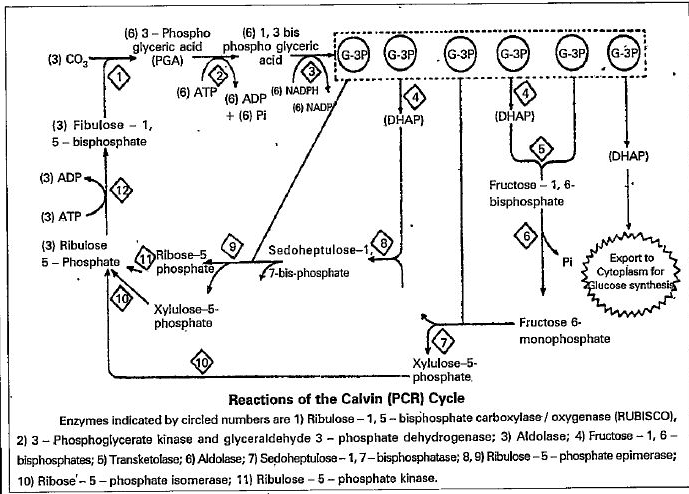...........phase in crucial in Calvin cycle for uninterrupted and continuous cycle . Solution in Telugu
The plants in which the first stable product of photosynthesis is 3 - PGA are called C3 plants. The path of carbon in C3 plants was traced by Melvin Calvin, Benson and S.A. Bashaam (1945-1957).
The path of carbon in C3 plants can be represented in the form of a cycle called reductive pentose phosphate pathway or Calvin - Benson cycle or Photosynthetic Carbon Reduction (PCR) cycle. It takes place in stroma of the chloroplast and includes three main parts, namely carboxylation, reduction and regeneration.
I. Carboxylation : The carbon atom of carbondioxide is first fixed by RuBP, A6 - Carbon unstable compound is formed. It is spontaneously hydrolyserd into two molecules of PGA. The enzyme RuBP ase (Rubisco) catalyses the reaction. The enzyme is light activated.
II. Reduction : The second part of path of carbon is reduction of PGA to phosphoglyceraldehyde. This part includes the following reactions.
1. PGA is phosphorylated by phosphoglycero kinase to yield B is PGA. ATP donates the phosphate group.
2. Bis PGA is reduced by phosphoglycero dehydrogenase to yield phosphoglyceraldehyde. NADPH donates the hydrogen atoms. Energy rich phosphate group is released.
Some molecules of phosphoglyceradehyde are used to form starch.
III. Regeneration : For the continuity of photosynthetic carbon reduction, the primary acceptor RuBP should be regenerted. Regeneration of RuBP takes place in three pathways.
First pathway :
1. Some molecules of PGAL (3c) are isomerised by triose phosphate isomerase to yield DHAP (3c).
2. Some molecules of DHAP and PGAL are condensed into fructose bis-phosphate (6c) by aldolase.
3. Fructose bis - phosphate is dephosphorylated into fructose monophosphate (6c) by phosphatase. The enzyme is light activated. Energy rich phosphate radical is released.
4. Fructose monophosphate reacts with PGAL to form xylulose monophosphate (5c) and Erythrose monophosphate (4c). Transketolase catalyses the reaction.
5. Xylulose monophosphate is epimerised into Ribulose monophosphate (5c) by phosphopentose epimerase.
6. Ribulose monophosphate is phosphorylated by phosphoribulokinase to regenerate RuBP (5c). ATP donated the phosphate group. The enzyme is light activated.
Second Pathway :
1. Erythrose monophosphate (4c) condenses with DHAP (3c) to form Sedoheptulose bisphosphate (7c) Aldolase catalyses the reaction.
2. Sedoheptulose bis - phosphate is dephosphorylated byphosphatase into sedoheptulose monophyosphate (7c). Energy rich phosphate radical is released. The enzyme is light - activated.
3. Sedoheptulose monophosphate (7c) reacts with PGAL (3c) to form xyulose monophosphate (5c) and ribose monophosphate (5c). Transketolase catalyses the reaction.
4. Xylulose monophosphate is epimerised by phosphopentose epimerase into Ribulose monophosphate (5c).
5. Ribulose monophosphate is phosphorylated by phosphoribulokin-ase to regenerate RuBP. ATP donates the energy rich phosphate group. The enzyme is light activated.
Third Pathway :
1. Ribose monophosphate (5c) is isomerised by phosphopentose isomerase into ribulose monophosphate.
2. Ribose monophosphate is phosphorylated by phosphoribulokinase to regenerate RuBP. ATP donates the energy rich phosphate group. The enzyme is light activated.

Topper's Solved these Questions
- PHOTOSYNTHESIS IN HIGHER PLANTS BOOK - VIKRAM PUBLICATION ( ANDHRA PUBLICATION)CHAPTER - PHOTOSYNTHESIS IN HIGHER PLANTS EXERCISE - IMPORTANT QUESTIONS
6 Videos
- PHOTOSYNTHESIS IN HIGHER PLANTS BOOK - VIKRAM PUBLICATION ( ANDHRA PUBLICATION)CHAPTER - PHOTOSYNTHESIS IN HIGHER PLANTS EXERCISE - EXERCISES
18 Videos
- PHOTOSYNTHESIS IN HIGHER PLANTS BOOK - VIKRAM PUBLICATION ( ANDHRA PUBLICATION)CHAPTER - PHOTOSYNTHESIS IN HIGHER PLANTS EXERCISE - SHORT ANSWER QUESTIONS
4 Videos
- ORGANIC EVOLUTIONBOOK - VIKRAM PUBLICATION ( ANDHRA PUBLICATION)CHAPTER - ORGANIC EVOLUTIONEXERCISE - SHORT ANSWER QUESTIONS
7 Videos
- PLANT GROWTH AND DEVELOPMENT BOOK - VIKRAM PUBLICATION ( ANDHRA PUBLICATION)CHAPTER - PLANT GROWTH AND DEVELOPMENT EXERCISE - EXERCISES
13 Videos
Similar Questions
What is photolysis of water ?
View SolutionBy looking at a plant externally can you tell whether a plant is C3orC4 ? Why and how?
View SolutionDraw a neat labelled diagram of chloroplast.
View SolutionWrite a bref note on Homologos and analogous organs.
View SolutionFill in the blanks with appropriate word/words.
a) The phase in which growth is most rapid is................
b) Apical dominance as expressed in dicotyledonous plants is due to the presence of more...............in the apical bud than in the lateral ones.
c). In addition to Auxin, a...............must be supplied to the culture medium to obtain a good callus in plant tissue culture.
d)...............of vegetative plants are the sites of photoperiodic perception.
View SolutionWhich of the following is most crucial step of Calvin cycle?
View SolutionWhich among the following is the most crucial step of the Calvin cycle ?
View Solution...........phase in crucial in Calvin cycle for uninterrupted and continuous cycle .
View SolutionName the most crucial step of Calvin cycle. What happens in it?
View SolutionWhere does Calvin cycle take place in chloroplast? Describe the three phases of Calvin cycle.
View SolutionThe most crucial step of calvin cycle is
View SolutionWhich of the following steps of the C_3 - cycle is crucial step to continue the cycle uninterrupted?
View Solutionकेल्विन चक्र का अत्यधिक निर्णायक चरण निम्न में कौन है?
View SolutionBiosynthetic phase/dark reaction | | Calvin cycle(c3-cycle)
View SolutionWhich of the following steps of the C_3 - cycle is crucial step to continue the cycle uninterrupted?
View SolutionDark phase is known as Calvin cycle' Evalute the statement.
View Solution
